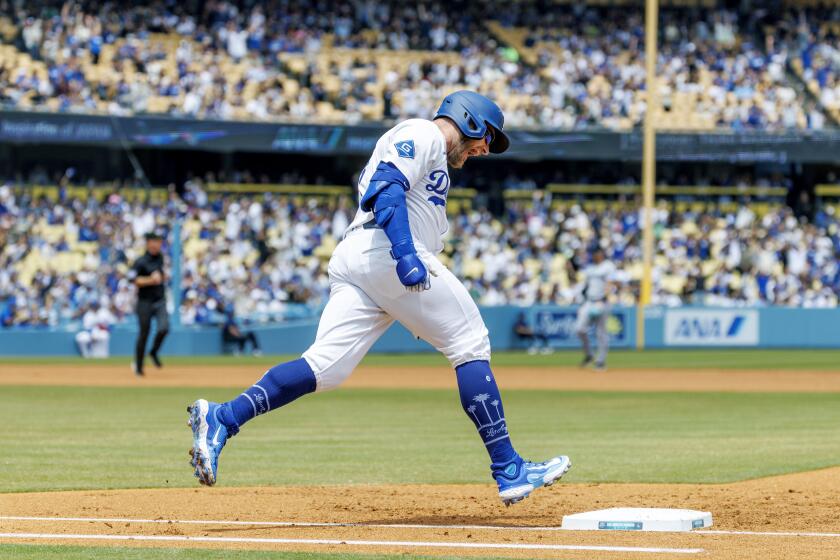George Nissen dies at 96; inventor of the modern trampoline
- Share via
George Nissen, who as a teenage gymnast was inspired to invent the modern trampoline after watching trapeze artists bounce off a safety net, has died. He was 96.
Nissen died Wednesday of complications from pneumonia at UC San Diego Thornton Hospital in La Jolla, said his daughter Dagmar.
He “was a true sports pioneer,” Steve Penny, president of USA Gymnastics, the sport’s national governing body, said in a statement. “His vision, innovations and passion sowed the seeds for trampoline’s worldwide popularity.”
More than 60 years after Nissen tested his first workable prototype, trampoline debuted as a medal sport in the 2000 Sydney Olympics.
“It is something I dreamt, like people winning a million dollars,” Nissen told reporters as he sat in the audience for the first night of Olympic trampoline competition.
Peter Vidmar, a 1984 Olympic gold medalist in gymnastics, called Nissen “a hero of mine.”
“He was so proud that the sport he pioneered had not only become an Olympic discipline, but that its appeal was truly global,” Vidmar said in a statement.
George Peter Nissen was born Feb. 3, 1914, in Blairs- town, Iowa, the youngest of four children of a Danish immigrant who ran a dry-goods store.
In high school, Nissen was a gymnast and diver when he made the serendipitous visit to the circus. Watching the acrobats rebound, he wondered if the net could help him train for his sports, he later said.
An early prototype crafted from canvas and junkyard scraps gave way to his first usable model, developed in 1934 from strips of inner-tube rubber while he was a University of Iowa student.
His coach, Larry Griswold, and the school of engineering gave him an assist.
At a YMCA summer swimming camp, Nissen tested out the bouncer. When “nobody wanted to go swimming,” he knew he was onto something, Nissen told Reuters news service in 2000.
At Iowa, he was a champion gymnast and in 1937 earned a bachelor’s degree in business.
With two friends, the new college graduate somersaulted his way around the country and Mexico as one of the “Three Leonardos,” performing what was then called “rebound tumbling.”
But Nissen wanted a catchier name and coined one after hearing the Spanish word trampolin, for “diving board” or “springboard.”
He trademarked the name “trampoline” but it eventually became the generic term for the apparatus that has proliferated in so many American backyards.
In 1941, he opened Griswold-Nissen Trampoline and Tumbling Co. in Cedar Rapids, Iowa, which manufactured and sold gymnastics equipment.
During World War II, he served in the Navy while trampolines were used to train pilots to learn how to orient themselves in the air.
After the war, Nissen started heavily promoting the trampoline by staging competitions and introducing it around the world.
His favorite publicity shot, taken in 1960 in New York’s Central Park, showed him jumping on a trampoline with a kangaroo that he rented for the occasion.
Another marketing coup took place in the 1970s atop an Egyptian pyramid when he reassembled a trampoline he had sneaked up and took a good bounce, his daughter said.
From 1947 to 1964, trampoline was a gymnastics event sanctioned by the Amateur Athletic Union and the National Collegiate Athletic Assn.
The sport long seen as the poor cousin of gymnastics took longer to crack the Olympics.
“There was a terrible lot of politics,” Nissen told the Des Moines Register in 2001. “I introduced it in 40 different countries over the span of 30 or 40 years after World War II.”
Nissen held more than 40 patents, according to USA Gymnastics. His other inventions included padded bleacher seats that fold up to create walls in a gym, and inflatable seat cushions for hunting and fishing.
After selling his trampoline business, Nissen moved to San Diego about 16 years ago.
An annual international trampoline competition in Switzerland is called the Nissen Cup, and what is now known as the Nissen-Emery Award has been given to the top male senior collegiate gymnast since 1966.
During a 2008 San Diego Union-Tribune interview, the 94-year-old Nissen stood firmly on his head and said: “There are really about three things in life that make you happy. Work and loving and creating.”
But then he added a fourth -- acceptance for a creation. It was a triumphant nod to his bouncing canvas that had risen to Olympic sport.
In addition to his daughter Dagmar, Nissen is survived by his wife, Annie, a former Dutch acrobat; another daughter, Dian; and a grandson.
More to Read
Go beyond the scoreboard
Get the latest on L.A.'s teams in the daily Sports Report newsletter.
You may occasionally receive promotional content from the Los Angeles Times.











